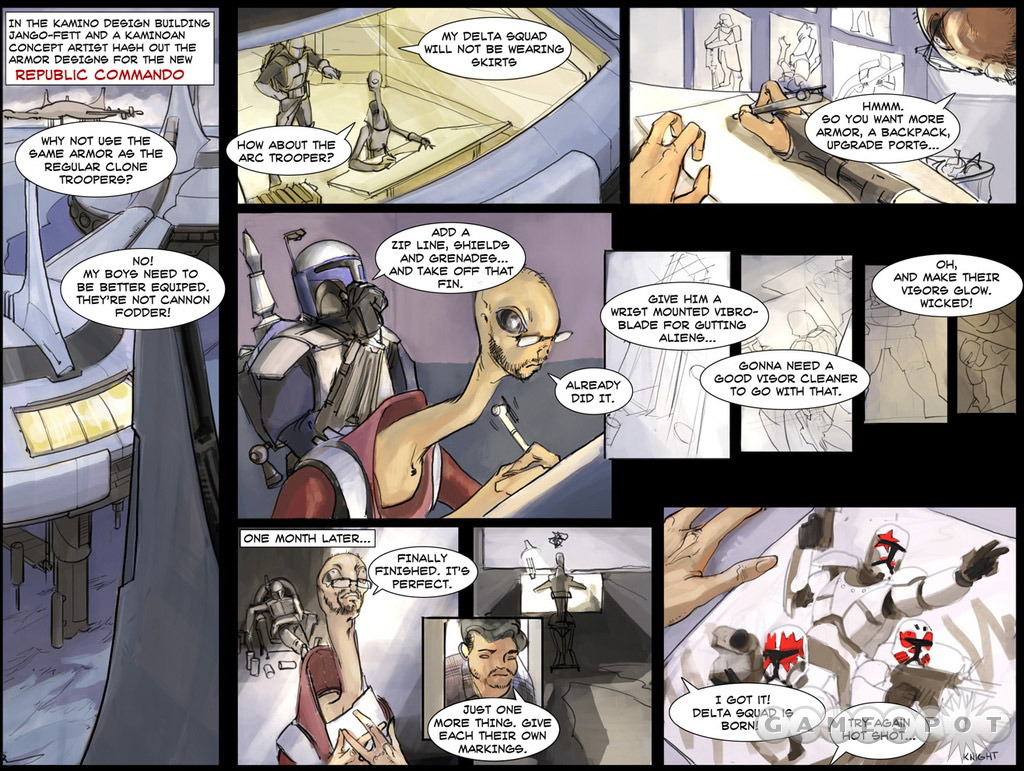Star Wars Republic Commando Designer Diary #2 - Clone Differentiation
Tap the Republic data bank and find out what makes the clones tick in LucasArts' upcoming squad-based shooter.
The upcoming Republic Commando will put you in control of a crack squad of clone troopers at the height of the infamous Clone Wars that nearly tore the galaxy apart. Our operatives on the Republic capital world of Coruscant have plumbed the depths of the government data archive and retrieved this information on the clone soldiers, which we present now for your consideration.
Republic Data Bank
Search Vector: Clone Differentiation
What follows is a summary of the clone commandos and how different personalities and talents emerged from their batch.
Factor H
Theoretically, all clones will develop identically in both physical and mental capacities. However, as the Kaminoan project advanced, clones started to spontaneously exhibit their own individual characteristics. The puzzled Kaminoan scientists labeled this quirk of human development "Factor H."
Commando Personalities
The clone commandos in particular showed a surprising amount of divergence in thought, personality, and general psychological makeup. Early on, the young clones were grouped into "pods" of four brothers. These groupings exaggerated existing traits, as the brothers would settle into distinct roles, like pod leader, second-in-command, and rebellious upstart. Following initial flash-education, the commando pods were assigned training sergeants, men and women handpicked by Jango Fett himself, from the ranks of the disbanded Mandalorian mercenaries. It wasn't long before the pods began assimilating the characteristics of their training sergeants. Some clones even adopted the particular accents of their instructors, while others, curiously, developed accents similar to Jango's Concord Dawn inflection. The sergeants, in turn, often encouraged clone differentiation by giving them unique nicknames.
But the Kaminoan scientists viewed all divergence as negative. They expected their clones to be perfect copies of one another. They wanted to recondition the entire batch. However, Jango quickly pointed out that in the case of the commandos, "The sum of the parts makes the whole stronger." Indeed, commando squads with distinct personalities performed better in the Killing House and in other critical test situations. The bounty hunter knew instinctively what the scientists could not grasp: The best soldiers are brothers…not clones.
The Kaminoans relented, and the experiment was allowed to continue.
Case Study: Delta

Delta squad was often touted as an example of the efficiencies created by clone differentiation. RC-1138 (aka "Delta Lead") clearly and definitively led the squad, both in rank and in spirit. The other commandos, though capable, deferred to his leadership, allowing the squad's decision-making speed and accuracy to increase exponentially. RC-1140 (aka "Fixer") fell in as the "second-in-command," unobtrusively supporting Delta Lead while maintaining his status as resident electronics and tech expert. While his skills didn't necessarily outclass his podmates, he expressed a preference, and the other clones complied. The other two clones were slower to develop personas. RC-1207 (aka "Sev") was noticeably more taciturn than the others, but his true skills blossomed when Sergeant Vau put a sniper rifle into his hands. After that moment, his brothers gave him a wider berth. And RC-1262 (aka "Scorch") found his niche as explosives expert and wisecracker. Even the grim Sergeant Vau recognized the need for a little levity, and he allowed Scorch to sound off now and then.
Armor Paint
As Delta squad rose to the top of its class, Jango Fett approached the Kaminoans with a proposal. The Mandalorians, his people, maintained a long-standing tradition of bearing unique armor "paints" -- that is, soldiers would modify their armor with stripes, colors, and other unique designs. This allowed them to identify one another instantly in combat, but it also gave the soldiers a sense of pride. Jango proposed that one squad be allowed to paint their armor, and the Kaminoans could monitor the effect on squad performance. Delta squad was chosen for this experiment, which is why they landed at Geonosis in armor paint, when all other troopers bore the stark white coloring of the Republic Grand Army. Later, as Delta squad proved that armor paint indeed improved squad morale, the entire Republic Army slowly adopted this practice.
(Ironically, the Kaminoans themselves are color blind in the visible human spectrum.)
Got a news tip or want to contact us directly? Email news@gamespot.com
Join the conversation